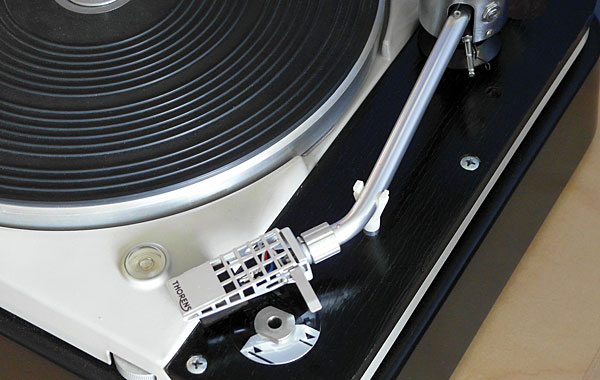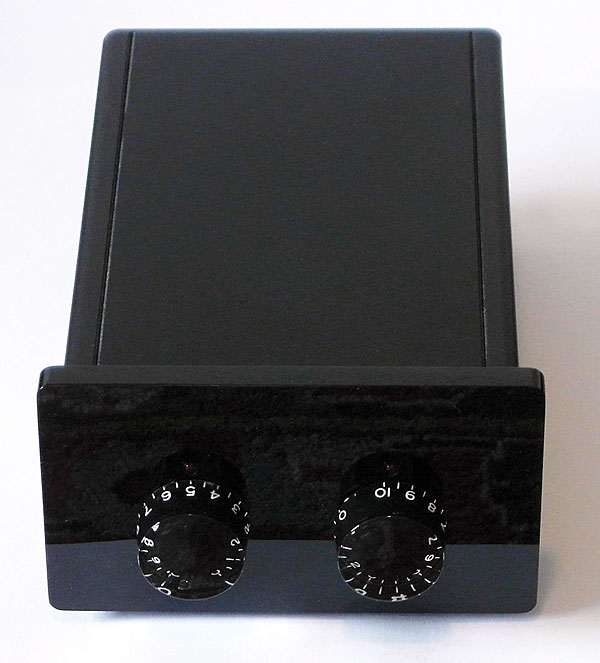Download
Popular Posts
-
Hey, we were in earthquake country, the land from which Carole King may have received inspiration to write, "I Feel the Earth Move...
-
Gibboni and the Gibbon: At Stereo Exchange’s annual Spring High-End Audio Show, Roger Gibboni (left) of Rogers High Fidelity debu...
-
The Enigmacoustics company from Irvine in California has become renowned for the self-energized, horn-loaded Sopranino electrostatic su...
-
A reader once noted that I tend to stick with the same reference gear longer than most reviewers. In addition to Audience's Au24e i...
-
Today, Sony announced an end to production on all MiniDisc players. In a few years, MiniDisc production will cease as well. I know w...
-
The name sounds perfect . It fits neatly next to those of Messrs. Leak, Sugden, Walker , Grant, Lumley, and others of Britain's...
-
Silicon Valley–based Velodyne was founded in 1983 to develop a range of subwoofers that used servo-control to reduce non-linear distorti...
-
I've heard a lot of great audio components over the years, but even in that steady stream of excellence, a few have stood out as so...
-
Once upon a time, in audio's infancy, anyone who wanted better than average sound—average sound during the 1940s being rich, boomy a...
-
I've long kept an eye on Michael Creek's loudspeakers (Epos) and electronics (Creek). He's always moving forward, with eith...
Market information
Blog Archive
-
▼
2013
(510)
-
▼
December
(15)
- This Christmas!
- Audience Au24 SE interconnect
- The Best Jazz Recordings of 2013
- Meet Mat Weisfeld, President of VPI Industries
- The Fifth Element #82
- Audio Beginnings
- My Favorite Records of 2013
- The Entry Level #36
- Lossy Compression: the Sonic Dangers
- Electrocompaniet Classic ECD 2 D/A processor
- Simaudio Moon Evolution 850P line preamplifier
- Listening #132
- Parasound Halo CD 1 CD player
- Stereophile's Products of 2013
- Wilson Audio Specialties Alexia loudspeaker
-
▼
December
(15)
Listening #132

Pity the aging perfectionist, the happy diversions of whose younger days—washing records, oiling turntables, leveling equipment racks, cleaning tube pins—have now become hated chores. And this from a man who used to redo his Roksan Xerxes setup every few months, just for "fun."
Sad irony, then, that an interest in mono LPs and shellacs came upon me so late in life, for it is a field in which the experts, among whose number I count God, would have me use different stylus profiles, different tonearm setups, different step-up transformers, and different playback-equalization curves when playing different mono records. I endure in doing the first three, because those things are necessary to both my enjoyment of music and to the preservation of my irreplaceable mono records (footnote 1). But I've never gone terribly far out of my way to fine-tune playback EQ, if only because I find that I'm not nearly as sensitive to lack of tonal accuracy as I am to lack of touch, impact, scale, presence, or drama.
Oh, me of little faith.
Double, double, toil and amplitude
Yet the need for some degree of playback equalization, howsoever unrefined, is a given. Bear in mind that the groove of a non-acoustically recorded record groove is created using an electromagnetic cutter head and played back using an electromagnetic pickup head, devices that convert mechanical energy to electrical energy, and vice versa. Remember also that, in all such things, the velocity of the mechanical signal at one end and the amplitude of the electrical signal at the other are directly proportional to one another—or, to put it more simply, as frequency goes up, so must voltage. That law, first described in 1831 by Michael Faraday, poses a challenge to any electrical phonograph: Because every doubling of frequency carries with it a concomitant doubling of voltage, an electromagnetic music-storage system with a 10-octave range would require an electrical range of, say, 1 to 1024V (or 1mV to 1.024V, or what-have you). That's just crazy.
The impracticality of such a wide range is problem enough, and yet the system brings with it a second challenge, of at least equal severity: If one were to use the same electromagnetic system of inscribing a 20Hz tone as a 20,000Hz tone, the disparity in size between the two would be so great that a single groove of useful width could not possibly contain both tones. Besides, the audio industry's ability to make a pickup capable of tracing, without distortion, the enormous groove excursions required for low frequencies and yet still respond to the microscopically small modulations required for the highest frequencies is, now as then, more than a bit doubtful.
Happily, the witches who cackled around the cauldron of the recording industry in the mid-1920s hatched an ingenious scheme: Rather than abandon altogether the notion of a spiral record groove—already made popular by the earlier acoustic Gramophones and Graphophones and Victrolas, whose 2.5-octave range and purely mechanical nature posed no Faradaysical challenges—they decided that, henceforth, electromagnetic cutter heads would be fed signals in which low frequencies are attenuated and high frequencies are boosted, both at the rate of 6dB/octave. Thus driven, those cutter heads could create grooves of usefully small size in which midtones are represented by constant-velocity modulations, yet the bass and treble ranges are transformed into constant-amplitude modulations. Neat.
Everyone left the coven with the same great idea—and went home and implemented it differently. From 1925 through 1953, virtually every manufacturer of phonograph records attenuated the bass and goosed up the highs of the signals driving their cutters (for a while, Victor changed only the lows, leaving everything else at constant velocity), all by the same 6dB rate. But most record labels used different hinge frequencies to define their EQ curves. A technical survey of records from Brunswick, Clef, Columbia, Decca, HMV, Mercury, Okeh, Victor, and dozens of others would reveal over 100 different combinations of hinge frequencies. And because the very concept of high fidelity implies that every cut-and-boost going in requires a complementary boost-and-cut coming out, a tremendous challenge was laid before the makers of playback gear—who, for the most part, ignored it. Of the preamps and integrated amps made during the classic age of the mono LP, surprisingly few can be adjusted for more than just a couple of different curves.
In 1954, as orchestrated by the recently formed Recording Industry Association of America, the world's record labels signed a treaty to end the war against fidelity: They agreed to an RIAA equalization standard that endures today, wherein the bass and treble hinge frequencies are respectively set at 500.5Hz and 2.122kHz (footnote 2). Those of us who listen to modern stereo LPs must, and generally can, trust that our phono stages are designed with the correct RIAA playback EQ.
Yet we remain ill equipped to hear, at their best, the hundreds of millions of mono records that remain on Earth. A handful of pre-RIAA–friendly phono preamplifiers are still being made, two of which—Esoteric Sound's extremely cost-effective Rek-O-Kut Re-Equalizer II ($369) and the all-tube Sentec EQ10 ($2850, footnote 3)—I've discussed in the January 2009 "Listening" column. Both provide adjustable gain to suit a variety of cartridge types, and both offer user-selectable EQ curves, with separate rotary switches for bass boost and treble rolloff.

Enter the Monophonic ($1500, footnote 4), a single-channel, perfectionist-quality phono preamp with a key distinction: It is, as far as I know, the only phono stage in which equalization settings are arrived at not by means of switches but with stepless, continuously variable potentiometers, thus offering far greater potential for fine tuning and ease of use.
Designed and made in Germany by a mono enthusiast named Michael Fehlauer, the Monophonic is a solid-state preamp with gain that's user-selectable (by means of a rear-mounted switch) for moving-coil, high-output moving-coil, and moving-magnet cartridges. (Input-impedance specs for these different settings are not published.) Measuring just 4" wide by 2.5" high by 7" deep (not counting its outboard power supply), the Monophonic is built into a distinctly well-made extruded case with a smooth satin-black finish. The front panel is glossy black methacrylate, adorned only with two barrel-style knobs that wouldn't look out of place on a Gibson Les Paul guitar: bass boost on the left, treble rolloff on the right. Each knob is marked with the numerals 1 through 10, as well as lines that correspond with those numbers and the points midway between them—and the Monophonic comes with a list of suggested settings for the EQ schemes of various record labels, including the modern RIAA standard (which requires the left knob to be set at 5.0 and the right knob at 4.0).
Behind each knob stands a Bourns potentiometer, and elsewhere inside the Monophonic, enjoying pride of place, reside two op-amps, their identifying markings sanded off. There are also two voltage regulators, nine resistors, two diodes, and a bunch of capacitors—all on a notably neat, well-finished board. The Monophonic is an unambiguously modern piece of gear made in an era when PCB stands for printed circuit board, not fish food.
Footnote 1: Yes, mono records continue to be made. But with one exception—the Electric Recording Company, whose records are frightfully expensive—no company I'm aware of is mastering their discs with a real mono cutter head, opting instead for stereo cutters wherein the two channels are summed. The resulting groove is not the same as a true mono groove cut to mono-era specs.
Footnote 2: The RIAA also came up with a third hinge frequency, suggesting that mastering engineers should revert to constant velocity below 50Hz, in order to avoid interference in the form of rumble.
Footnote 3: This was recently replaced with the identically priced and newly stereo-friendly Sentec EQ11, which I have not heard.
Footnote 4: US distributor: Oswalds Mill Audio. Tel: (917) 743-3780. Web: www.oswaldsmillaudio.com
Source : stereophile[dot]com

- Không có bài viết liên quan

Comments[ 0 ]
Post a Comment